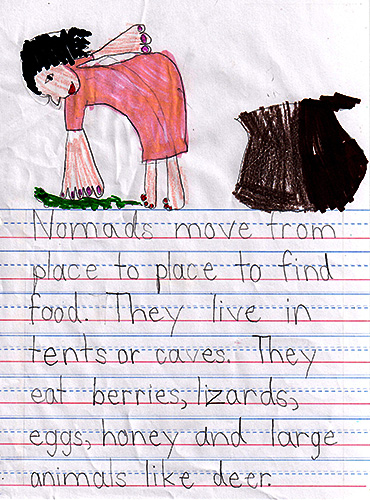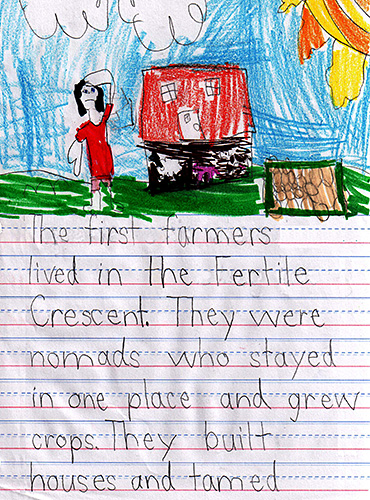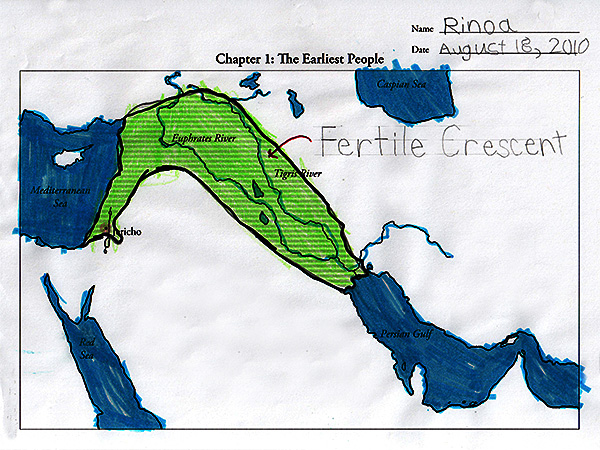I’m sure I’ve mentioned in the past that history has become Rinoa’s favorite subject. Each morning as we start our schoolwork, she would ask me if she has history lessons that day. When she doesn’t (since I alternate history and science), she would plead to have history – much to Mica’s irritated astonishment. (Haha!)
My curriculum is loosely based on the The Well-Trained Mind, and as such, I use the The Story of the World
by Susan Wise Bauer to teach Rinoa history. (This is a four-volume series. We are currently using Volume I and studying about Ancient Times.) During class, I read to her a chapter from the book. (Sometimes we read together.) The book, written for grade school children, has an easy-to-read narrative style that introduces historical events and keeps Rinoa constantly engaged on the lesson. As I read to her, I ask her questions to make sure she understands what we’re reading. I also use a large wall map to show her various places and areas as we come across them. Afterwards I give her time to write down a short summary of what we just read and draw a picture to go with her narration. (According to the Well-Trained Mind, “narration is a way to develop the child’s understanding and storytelling skills.”)
Here are a few narration pages that Rinoa made for her lesson on “The Earliest People”:

Nomads by Rinoa Redington (5 years old)
The drawing shows a young nomad catching a lizard to give to her mom to cook for breakfast. The narration is as follows: “Nomads move from place to place to find food. The live in tents or caves. They eat berries, lizards, eggs, honey, and large animals like deer.”

The First Farmers by Rinoa Redington (5 years old)
The drawing shows a farmer hard at work. (He is wiping off his sweat.) He keeps his livestock beside his house (in the middle) and he has a field of crops on the right. The narration is as follows: “The first farmers live in the Fertile Crescent. They were nomads who stayed in one place and grew crops. They built houses and tamed animals like sheep and goats.”

Map Work by Rinoa Redington (5 years old)
When Rinoa is done with her narration page, we do some map work. This one shown here is from the activity book that goes with the Story of the World. (It is bought separately but is a huge time-saver.) Aside from the map work, the activity book includes review questions, sample narrations, coloring pages (which Rinoa love!), and lots of projects.
I supplement the Story of the World with the Usborne Internet-Linked Encyclopedia of World History. The colorful illustrations in the book help Rinoa picture more vividly the lessons that we discuss. Some of the internet resources, especially the ones designed for children, reinforce our studies and keep Rinoa entertained.
Here’s a summary of the books I use for grade school history:
- Story of the World, Volume 1: Ancient Times (for use in first grade)
- Story of the World, Activity Book 1
- Story of the World, Volume 2: Middle Ages (for use in second grade)
- Story of the World, Activity Book 2
- Story of the World, Volume 3: Early Modern Times (for use in third grade)
- Story of the World, Activity Book 3
- Story of the World, Volume 4: The Modern Age (for use in fourth grade)
- Story of the World, Activity Book 4
- Usborne Internet-Linked Encyclopedia of World History (for use with all Story of the World books)
| Con mucho amor, | ||
 |
Oh Johwey, I didn’t know you homeschool. I did too, for 11 years. Our youngest is a senior now. Wow! How time flies. What a fabulous lapbook!This post brought back warm fuzzies for me as I remember doing lapbooks with my kids when we homeschooled. They, and I, still remember so much. xo